Gujarat Board GSEB Solutions Class 9 English Second Language Chapter 5 Rani Ki Vaav Textbook Exercise Questions and Answers.
GSEB Class 9 English Textbook Solutions Chapter 5 Rani Ki Vaav (Second Language)
GSEB Class 9 English Rani Ki Vaav Text Book Questions and Answers
(A) Look at this picture of the Somnath temple.
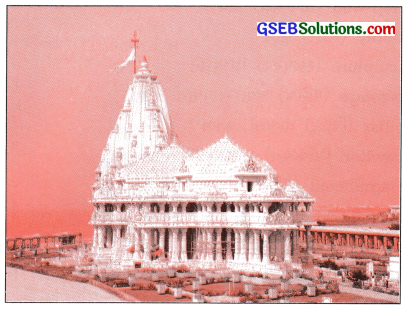
Now fill in the blanks using the words given in the brackets and complete the paragraph.
(sea, carved, enchanting, majestic, Somnath, flag, pillars, peak, roof)
This temple of Somnath is a great architectural example of Hindu temples. The peak is called the ‘shikhara’. This roof is also known as the ‘steeple’ or ‘dome’. The temple faces the east and has a big central hall with three entrances. It has richly carved doorways. The endless pillars are called ‘stambhas’. They make it look spectacular. There is a flag on the tallest peak of the temple. We can also see carved domes. The whole structure looks enchanting and majestic. This temple is near the sea.
![]()
(B) Look at the picture of Mohabbat Maqbara located in Junagadh and say whether the sentences are True or False.
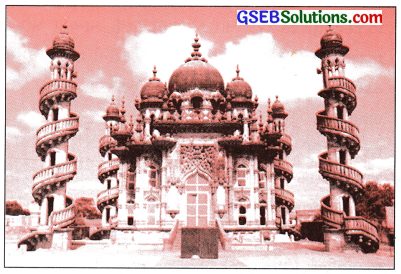
(1) There are two minarets around the Maqbara. – False
(2) The domes are full of carvings on them. – True
(3) The minarets look beautiful because the stairs are spiral. – True
(4) There is no scope of having a view of Junagadh from the Maqbara. – False
(5) The Maqbara is a king’s palace. – False
(6) There are five domes on the main structure. – True
(C) State which of these should be done or should not be done while visiting a historical monument. Write ‘Yes’ or ‘No’ at the end of the sentence.
(1) Use flashlight if dark inside. — No
(2) Touch the carving, feel it and enjoy it. — No
(3) Making noises. — No
(4) To record visit, carve your name only on the comer stones. — No
(5) Keep the place clean. — Yes
(6) Listen to the guide carefully. — Yes
(7) Scratch the exhibits to check its material. — No
(8) Ask questions to your teacher or a guide. — Yes
![]()
Vocabulary
1. Find the sentences having a group of words almost similar in meaning in the text.
(1) Your great work for the society will get very large praise.
UNESCO has recognized this masterpiece as an exceptional example of water management system.
(2) The Taj Mahal is a decorative example of a great monument.
The Vaav is the most developed, elaborate and ornamental example of submerged architecture.
(3) Amit’s name was proposed for the ‘Best Student’ award by the committee.
In February, 2013 AS1 nominated this Vaav for the World Heritage list.
(4) You will find some distinctive idols of goddesses in the temple.
There are also some rare sculptures of gods.
(5) Akbar was one of the kings from the Moghul king’s family.
King Bhimdev -1 belonged to the Solanki dynasty of Anhilwad Patan.
(6) Shah Jahan built the Taj Mahal in 1632.
Queen Udayamati, the widow of King Bhimdev-I, constructed the Vaav between 1022 and 1063 AD.
(7) Each painting in the Ajanta caves has an appealing effect to the visitors.
Rani ki Vaav has a great appeal to every observer.
2. Complete the paragraph using the words from the brackets with the help of your partner.
(heritage, sculptures, blend, architectural, ornamental, construction, designs, enchanting)
The world heritage site of Fatehpur Sikri is located about 39 km from Agra in U.P. The city is about three miles long and one mile wide. Built with red sikri stone, the city is a blend of Islamic and Hindu architectural style. The sandstone throughout the city has exquisite sculptures and interlaced decorative designs. The planning and construction of the walled city took 15 years. It is an enchanting place to visit.
![]()
3. Put a tick mark against the word which is nearly opposite in meaning.

Comprehension
1. Find out the details about ‘Rani ki Vaav’ from the text and fill in the table.
| No. | Detail | Description |
| 1 | Built by and during | Queen Udayamati, the widow of King Bhimdev-1 between 1022 AD and 1063 AD. |
| 2 | Built at | Patan |
| 3 | Storeys | Seven |
| 4 | Length | 64 metres |
| 5 | Width | 20 metres |
| 6 | Depth of the well | 27 metres |
| 7 | Number of sculptures | 400 |
| 8 | Names of deities in sculptures | Vishnu, Parvati, Varah, Vaman, Narsinha, Ram, Kalki, Mahishasurmardini, Shiva, Lord Buddha, Ganesha, Agni, Vaayu, Surya, Bhairav, Chamunda, Brahma, Indra, Indrani, Vaishnavi, Varahi, Mahalakshmi, Kuber, Gauri, Uma, Lalita, Shriya, Krushna, Maheshwari, Rambha, Savitri, Trisanda, Total and Tripura. |
| 9 | Purpose of building the Vaav | Solving the problem of water scarcity faced by the people of Patan |
| 10 | Got recognition by | UNESCO |
Write a paragraph using the details and description mentioned in the above table.
The Rani ki Vaav was built by Queen Udayamati, the widow of King Bhimdev -1. After the death of King Bhimdev-I, Udayamati took up the project for solving the problem of water scarcity faced by the people of Patan. She got the Vaav constructed between 1022 and 1063 AD.
Rani ki Vaav is a seven-storeyed structure. It is 64 metres long, 20 metres wide and 27 metres deep. There are nearly 400 big sculptures of different gods and goddesses in the Vaav at present. The Vaav is solely dedicated to Vishnu. After Vishnu, the next important statue is of Parvati. There are all the twelve statues of Gauri namely – Uma, Parvati, Gauri, Lalita, Shriya, Krushna, Maheshwari, Rambha, Savitri, Trisanda, Total and Tripura.
![]()
Besides them, there are many statues of Ganesha, Agni, Vaayu, Surya, Bhairav, Chamunda, Brahma, Indra, Indrani, Vaishnavi, Varahi, Mahalakshmi, Kuber, etc. There are attractive sculptures of Varah, Vaman, Narsinha, Ram, Kalki and Mahishasurmardini. There is a statue of Lord Buddha and Parshurama also. In February, 2013, ASI nominated this Vaav for the World Heritage list. It got recognition by the UNESCO.
2. Answer the questions.
Question 1.
Who declared Rani ki Vaav an approved heritage site?
Answer:
UNESCO declared Rani ki Vaav as an approved heritage site.
Question 2.
Why was the Vaav built?
Answer:
The Vaav was built to solve the problem of water scarcity in Patan.
Question 3.
Which dynasty did King Bhimdev -1 belong to?
Answer:
King Bhimdev -1 belonged to the Solanki dynasty of Anhilwad Patan.
Question 4.
What is carved on the side walls of the Vaav ?
Answer:
About 800 sculptures are carved on the side walls of the Vaav.
![]()
Question 5.
Name the twelve different statues of Gauri in the Vaav.
Answer:
There are twelve statues of Gauri namely-Uma, Parvati, Gauri, Lalita, Shriya, Krushna, Maheshwari, Rambha, Savitri, Trisanda, Total and Tripura.
Question 6.
Why was the Vaav buried?
Answer:
The Vaav was buried under mud due to floods first, and then the vanishing of river Saraswati.
Question 7.
How long was the Vaav hidden?
Answer:
The Vaav was hidden for almost seven centuries.
Question 8.
Who takes care of the Vaav nowadays?
Answer:
Nowadays, the ASI (Archeological Survey of India) takes care of the Vaav.
Question 9.
Which are the rare sculptures of Gods in the Vaav?
Answer:
Some of the rare sculptures are of Z- Lord Buddha with four hands, Lord Rama with a sword and shield, Sun in the form of a tapasvi, Lord Shiva with beads in his hand and Parshurama with soft and gentle expression rather having hard and stern look.
- Vishnu
- Ganesha
- Agni
- Vaayu
- Surya
- Bhairav
- Indra
- Brahma
- Kuber
- Varah
- Vaman
- Narsinha
- kalki
- Lord Buddha with four hands
- Lord Rama with a sword and shield
- Sun in the form of a tapasvi
- Lord Shiva with beads in his hand
Goddesses:
- Parvati: There are all the twelve statues of Gauri namely – Uma, Parvati, Gauri, Lalita, Shriya, Krushna, Maheshwari, Rambha, Savitri, Trisanda, Total and Tripura.
- Chamunda
- Indrani
- Vaishnavi
- Varahi
- Mahalakshmi
- Mahishasurmardini
![]()
Have you ever visited a historical place? What did you see there ? What information of that place did you get?
During my summer vacation, I went to see the Taj Mahal with my family. It is famous as
one of the seven wonders of the world. The Taj Mahal was built by Shah Jahan in memory of his beloved queen Mumtaz Mahal. The Taj Mahal is on a raised platform.
It has a big central dome, which gives the Taj Mahal its unique beauty. There are four smaller domes on the four corner minarets. It is said that twenty thousand workmen worked for twenty long years to create this beautiful piece of architecture.
Yes, the Taj Mahal is rightly called ‘a dream in marble’. At night, the Taj appears to be bathing in the beautiful moonlight. The reflection of the Taj Mahal in the waters of the Yamuna was a sight I will never forget all my life.
Language Practice
Question 1.
Enjoy the story and observe the underlined words.
Answer:
Who is stronger?
One day the Wind said to the Sun, “I’m as strong as you.”
The Sun laughed and said, “What a silly person you are! I’m far stronger than you.” They decided to put it to a test. “There goes a man with a jacket, along the mountain road,” said the Wind. “Can you make him take off his jacket ?” “Why don’t you try first?” said the Sun.
The Wind puffed out his cheeks and blew. The man put his head down and walked on. Then the Wind blew harder and harder, but the man only held his jacket tighter against his body. The Wind gave up and asked the Sun to try.
![]()
The Sun just smiled and it became as warm as a summer day. The man was not comfortable and he opened the buttons of his jacket. The Sun now shone brighter and brighter and the man felt warmer and warmer. He began to perspire and was soon tired. He sat on a stone and took off his jacket. And now he was more comfortable than before.
2. (A) Read the data and frame at least 8 sentences as shown.
| Soor | Indra | Kumar |
| 165 cms | 170 cms | 165 cms |
| 69% | 69% | 70% |
| 58 kg | 67 kg | 67 kg |
| 17 years | 17 years | 17 years |
Now read the sentences.
Example : Soor is as tall as Kumar.
Indra is taller than Soor.
(1) Soor is as clever as Indra.
Kumar is cleverer than Soor.
(2 ) Indra is as fat as Kumar.
Kumar is fatter than Soor.
(3) Soor is as old as Indra.
Kumar is as old as Soor.
(4) Kumar is as short as Soor.
Soor is shorter than Indra.
(5) Kumar is as thin as Indra.
Soor is thinner than Kumar.
(B) Select the pair of words from A and compare them by choosing the appropriate words from B and make sentences
| A | B |
| gold-iron | bigger |
| elephant-dog | cheaper |
| water-oil | faster |
| balloon-ball | thinner |
| train-bus | heavier |
Example : Iron is cheaper than gold.
(1) An elephant is bigger than a dog.
(2) Water is thinner than oil.
(3) A ball is heavier than a balloon.
(4) A train is faster than a bus.
![]()
3. Find out the opposites of words in A.
| A | B |
| stronger | weaker |
| harder | easier /softer |
| smaller | bigger |
| warmer | cooler |
| lighter | darker / heavier |
Now fill in the blanks using the appropriate words two times in each sentence.
(1) Gandhiji started his fast. After a week he became weaker and weaker.
(2) By the time we reached the mountain in the evening, it became darker and darker.
4. Notice the words. Write three sentences using ‘…er than’ and three sentences using ‘more … than’.
| as hot as | hotter than |
| heavy | heavier |
| sweet | sweeter |
| clever | cleverer |
| wide | wider |
| beautiful | more beautiful |
| useful | more useful |
| comfortable | more comfortable |
| handsome | more handsome |
| intelligent | more intelligent |
| famous | more famous |
Note : Generally ‘more’ is used with words having two or more syllables.
- Iron is heavier than plastic.
- Rasgulla is sweeter than chocolate.
- Soham is cleverer than Rohan.
- The Sabarmati is wider than the Mahi.
- The peacock is more beautiful than a peahen.
- A bicycle is more useful than a camera.
- This chair is more comfortable than that chair.
- Dev is more handsome than his brother.
- Kiran is more intelligent than Sejal.
- Modi is more famous than Rahul.
5. Frame two sentences for each pair.
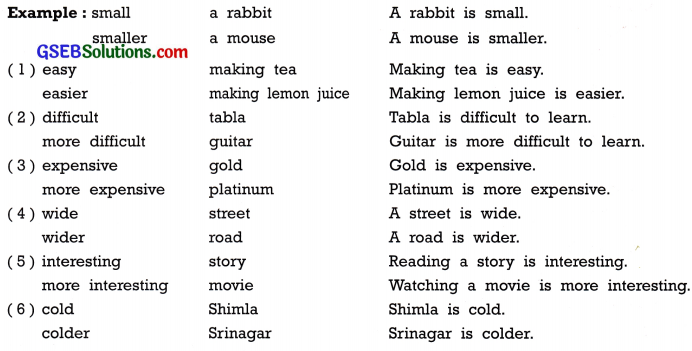
![]()
6. Write names and objects in the boxes. Frame and speak at least four sentences comparing them. Try to use ‘as … as’, ‘… er than’ or ‘more … than’. Work in pairs.
| Animals | Household objects | Well-known persons | ||||||
| Size | Weight | Speed | Kitchen | Drawing Room | Garden | Sports | Music | Politics |
| large small |
heavy light |
fast slow |
useful, cheap, expensive | famous, | popular, young, old | |||
| elephant | Hippo- | cheetah | fridge | TV | swing | Mary | Zakir | Narendra |
| rabbit | potamus | tiger | mixer | sofa | flower- | Kom | Husain | Modi |
| tortoise | donkey | horse | gas | fan | pot | Saina | Amaan | Rahul |
| horse | stove | Nehwal | Ali Khan | Gandhi | ||||
(1) A rabbit is as small as a tortoise.
An elephant is larger than a rabbit.
(2) A donkey is as heavy as a horse.
A horse is lighter than a hippopotamus.
(3) A cheetah runs as fast as a tiger.
A horse runs slower than a cheetah.
(4) A gas stove is as useful as a fridge.
A fridge is more expensive than a gas stove.
A mixer is cheaper than a fridge.
(5) A sofa is as useful as a fan.
A TV is more expensive than a fan.
A fan is cheaper than a sofa.
(6) A swing is more expensive than a flower-pot.
A flower-pot is cheaper than a swing.
(7) Saina Nehwal is as popular as Mary Kom.
Saina Nehwal is more famous than Mary Kom.
Saina Nehwal is younger than Mary Kom.
Mary Kom is older than Saina Nehwal.
(8) Zakir Husain is as popular as Amaan Ali Khan.
Zakir Husain is more famous than Amaan Ali Khan.
Amaan Ali Khan is younger than Zakir Husain.
Zakir Husain is older than Amaan Ali Khan.
(9) Narendra Modi is as famous as Rahul Gandhi
Narendra Modi is more popular than Rahul Gandhi.
Rahul Gandhi is younger than Narendra Modi.
Narendra Modi is older than Rahul Gandhi.
Writing
1. Work in pairs. Read the following map of Rani ki Vaav and surroundings and fill in the details the following paragraph.
Note : To be done by students.
2. Write a paragraph on your visit of a historical or an archeological place.
Last Sunday, my family and I visited Lothal. It is about 85 km from Ahmadabad. Lothal is the ruins of the first Indian Port (between 2400- 1800 BC). It belongs to the Indus Valley Civilization. It was discovered in 1954 by ASI (Archeological Survey of India
Lothal is a unique example of a very high degree of town planning. The town was divided into blocks of 1-2 metre- high (3-6 ft) platforms of sun-dried bricks, each serving 20-30 houses of thick mud and brick walls.
The city was divided into a citadel or acropolis and a lower town. The rulers of the town lived in the acropolis, which had paved baths, underground and surface drains (built of kiln-fired bricks) and a potable water well.
![]()
The lower town was subdivided into two sectors. A north-south arterial street was the main commercial area. It had shops of rich and ordinary merchants and craftsmen. The residential area was located to either side of the market place
We also visited the museum, where we saw more than 4000-year-old seals of the Indus Valley Civilization. There were terracotta artifacts (pieces), vessels, ancient beads and necklaces made from colourful, semi-precious stones and paintings. We learnt a lot about the Indus Valley Civilization. It was knowledge with fun.
3. Make a list of ten historical or archeological places of Gujarat. Write two sentences about each of them.
(1) Rani ki Vaav : It is a step-well in Patan. It was built by Queen Udayamati to solve the problem of water scarcity of the people of Patan. It has more than 400 sculptures of gods and goddesses in it. It is a unique example of water management system.
(2) Lothal: It is an archeological site discovered by ASI in 1954. It is the ruins of Lothal, which was a port city of the Indus Valley Civilization. It is an excellent example of town planning.
(3) Sun Temple, Modhera : It is a temple dedicated to the Surya – the Sun God. It is 102 km from Ahmadabad. It was built in 1026 AD by King Bhimdev of the Solanki dynasty. The temple was so designed that the first rays of the sun fell on the image of Surya, the Sun God, at the time of equinoxes.
(4) Hriday Kunj : It is the place where Gandhiji lived in the Sabarmati Ashram in Ahmadabad. There is a library, a prayer ground and a museum near Hriday Kunj.
(5) Kirti Mandir : It is a national monument, as it happens to be the birthplace of Mahatma Gandhi. This place has some religious importance, as it is also the birthplace of the legendary character Sudama, who was supposed to be Lord Krishna’s best friend.
(6) Vadnagar : Vadnagar is famous for its torans and Hatkeshwar temple. Torans are a pair of 12th century columns supporting an arch, about 40 feet tall, built in red and yellow sandstone, just north of the walled town. The Hatkeshwar temple is a 17th century carved temple at the entrance of the town. The Shiva Linga is said to have self-emerged (swayambhu).
(7) Dholavira : It is located in Kutch, in Gujarat. It was an Indus Valley settlement known for its sophisticated urban planning and architecture. Dating back to 2900 BC, all the buildings are almost exclusively built out of brick. Dholavira has sophisticated water conservation systems, possibly the oldest in the world.
(8) Champaner-Pavagadh : Pavagadh along with Champaner and Machi is a UNESCO world heritage site. This site reflects grand historical confluence, displaying 1,200 years of history and culture. It is believed to bear testimony to the Indian Puranic ages, the Rajput saga, the Maratha rule, the Islamic influences and finally the British occupation within its remains.
(9) Adalaj Vaav:Adalaj is a village 18 kms to the north of Ahmadabad. The Vaav (step-well) at Adalaj derives its name from the lady patron, Ruda, wife of the Vaghela chief, Virsinh, who built it in the 15th or 16th century AD.
![]()
(10) Rudra Mahal (Siddhpur): It was built as an honour to Mahadev, by the first Solanki king of Gujarat, Mulraj. Construction of the Rudra Mahal started probably in 983 AD and took 175 years to complete.
Comprehension
A. Read the extracts and answer the questions.
(1) Rani ki Vaav (step-well) is an approved site on the world heritage list. It was declared by the UNESCO at the world heritage committee. UNESCO has recognized this masterpiece as an exceptional example of water management system.
Question 1.
Who declared Rani ki Vaav an approved site?
Answer:
UNESCO declared Rani ki Vaav as an approved site.
Question 2.
What is the Vaav an example of?
Answer:
The Vaav is an example of water management system.
(2) It is a wonderful sample of technological development for utilizing ground water resources in a single structure. It is also a unique illustration of breaking large spaces into smaller volumes with artistic presentation. Rani ki Vaav has a great appeal to every observer.
Question 1.
What is the Vaav a wonderful sample of?
Answer:
The Vaav is a wonderful sample of technological development to use ground water resources in a single structure.
Question 2.
What is the Vaav an illustration of?
Answer:
The Vaav is a unique illustration of breaking large spaces into smaller volumes with artistic presentation.
![]()
(3) Queen Udayamati, the widow of King Bhimdev -1, constructed this Vaav between 1022 and 1063 AD. Rani ki Vaav has become one of the most popular places to visit in Gujarat. King Bhimdev -1 belonged to the Solanki dynasty of Anhilwad Patan.
After his death, Udayamati took up the project for solving the problem of water scarcity faced by the people of Patan. Unfortunately, the queen also died before the completion of this structure. In the world of architecture, her beautiful idea has received immense appreciation.
Question 1.
To which dynasty did King Bhimdev -I belong?
Answer:
King Bhimdev -1 belonged to the Solanki dynasty of Anhilwad Patan.
Question 2.
Who constructed the Vaav?
Answer:
Queen Udayamati, the widow of King Bhimdev -1 constructed the Vaav.
Question 3.
Why did Queen Udayamati build the Vaav?
Answer:
Queen Udayamati built the Vaav to solve the problem of water scarcity faced by the people of Patan.
Question 4.
When was the Vaav constructed?
Answer:
The Vaav was constructed between 1022 and 1063 AD.
(4) Queen’s step-well or Rani ki Vaav is a seven-storeyed structure. This East facing step-well is 64 metres long, 20 metres wide and 27 metres deep. Each sculpture, passage, pillar and pavilion in this magnificent structure has enchanting carvings. On its side walls there are around 800 sculptures.
Question 1.
What is carved on the side walls of the Vaav?
Answer:
About 800 sculptures are carved on the side walls of the Vaav.
Question 2.
How many storeys does the Vaav have?
Answer:
The Vaav has seven storeys.
Question 3.
How big is the Vaav?
Answer:
The Vaav is 64 metres long, 20 metres wide and 27 metres deep.
Question 4.
Which parts of the Vaav have enchanting carvings?
Ans.
Each sculpture, passage, pillar and pavilion in the Vaav has enchanting carvings.
(5) There are nearly 400 big sculptures of different gods and goddesses in the Vaav at present. These numbers would have been many more in the past in its original structure. Each storey has a narrow corridor for the visitors to appreciate the beauty of sculptures and carvings engraved on the walls. Even the pillars of the Vaav are not an exception to it. They display splendid artistic marvel on stone.
Question 1.
How many sculptures are there in the Vaav at present?
Answer:
At present, there are 400 big sculptures of gods and goddesses in the Vaav.
Question 2.
Why does each storey have a narrow corridor?
Answer:
Each storey has a narrow corridor for the visitors to appreciate the beauty of sculptures and carvings on the walls.
![]()
Question 3.
What do even the pillars display?
Answer:
Even the pillars display splendid artistic marvel on stone.
(6) In fact, the Vaav is solely dedicated to Vishnu. One can find Vishnu in different shapes and postures. Most of them present Vishnu in his ten different avatars. After Vishnu, the next important statue is of Parvati. Nearly 15 galleries have the sculptures of Parvati. 12 statues of goddess Gauri together at the same place are rarely found anywhere. The Sun temple of Modhera has it. This Vaav also has all the twelve statues of Gauri namely – Uma, Parvati, Gauri, Lalita, Shriya, Krushna, Maheshwari, Rambha, Savitri, Trisanda, Total and Tripura.
Question 1.
Name the twelve different statues of Gauri in the Vaav.
Answer:
There are twelve statues of Gauri _ namely – Uma, Parvati, Gauri, Lalita, Shriya, Krushna, Maheshwari, Rambha, Savitri, Trisanda, Total and Tripura.
Question 2.
To which god is the Vaav dedicated?
Answer:
The Vaav is dedicated to Vishnu.
Question 3.
How do the sculptures present Vishnu?
Answer:
The sculptures present Vishnu in his ten different avatars, in different shapes and postures.
Question 4.
How many galleries have the sculptures of Parvati?
Answer:
Nearly 15 galleries have the sculptures of Parvati.
Question 5.
Besides Rani ki Vaav, where can you see 12 statues of Goddess Gauri?
Answer:
Besides Rani ki Vaav, we can see 12 statues of Goddess Gauri in the Sun Temple at Modhera.
(7) There are also some of the rare sculptures of gods. Here one can find the statue of Lord Buddha with four hands, the statue of Rama with a sword and shield, the statue of Sun in form of a tapasvi, the statue of Shiva with beads in his hand, the statue of Parshurama with soft and gentle expression rather than having hard and stern look, etc.
Question 1.
Which are the rare sculptures of gods in the Vaav?
Answer:
Some of the rare sculptures are of Lord Buddha with four hands, Lord Rama with a sword and shield, Sun in the form of a tapasvi and Lord Shiva with beads in his hand.
Question 2.
How does the sculpture present Parshurama?
Answer:
The sculpture presents Parshurama with a soft and gentle expression instead of a hard and stern look.
![]()
Question 3.
Why is the statue of Rama rare?
Answer:
The statue of Rama is rare because it has a sword and a shield in its hand. contemporary lifestyle, folk tales, animal and human instinct, etc.
(8) Some of the sculpture display contemporary lifestyle, folk tales, animal and human instinct, etc. They reveal the artistic vision and unique imagination of the sculptors. The most attractive sculptures are those of Varalt, Vaman, Narsinha, Ram, Ka.lki and Mahishasurmardini.
Question 1.
What do some of the sculptures display?
Answer:
Some of the sculpture display contemporary lifestyle, folk tales, animal and human instinct, etc.
Question 2.
What do the sculptures reveal?
Answer:
The sculptures reveal artistic vision and unique imagination of the sculptors.
Question 3.
Which are the most attractive sculptures?
Answer:
The most attractive sculptures are those of Varah, Vaman, Narsinha, Ram, Kalki and Mahishasurmardini.
(9) There are nearly 300 statues of apsaras. The sculptors have presented a vast range of emotions and feelings on the faces of the apsaras. They display a variety of different moods and situations. The apsaras with 16 different makeup styles add to the grace of this unmatched structure.
Question 1.
What have the sculptors presented on the faces of the apsaras?
Answer:
The sculptors have presented a vast range of emotions and feelings on the faces of the apsaras.
Question 2.
What do the statues of the apsaras display?
Answer:
The statues of the apsaras display variety of moods and situations.
Question 3.
What adds to the grace of the structure ?
Answer:
The apsaras with 16 different makeup styles add to the grace of the structure.
![]()
(8) Some of the sculpture display contemporary lifestyle, folk tales, animal and human instinct, etc. They reveal the artistic vision and unique imagination of the sculptors. The most attractive sculptures are those of Varah, Vaman, Narsinha, Ram, Kalki and Mahishasurmardini.
Question 1.
What do some of the sculptures display?
Answer:
Some of the sculpture display contemporary lifestyle, folk tales, animal and human instinct, etc.
Question 2.
What do the sculptures reveal?
Answer:
The sculptures reveal artistic vision and unique imagination of the sculptors.
Question 3.
Which are the most attractive sculptures?
Answer:
The most attractive sculptures are those of Varah, Vaman, Narsinha, Ram, Kalki and Mahishasurmardini.
(9) There are nearly 300 statues of apsaras. The sculptors have presented a vast range of emotions and feelings on the faces of the apsaras. They display a variety of different moods and situations. The apsaras with 16 different makeup styles add to the grace of this unmatched structure.
Question 1.
What have the sculptors presented on the faces of the apsaras?
Answer:
The sculptors have presented a vast range of emotions and feelings on the faces of the apsaras.
Question 2.
What do the statues of the apsaras display?
Answer:
The statues of the apsaras display variety of moods and situations.
Question 3.
What adds to the grace of the structure?
Answer:
The apsaras with 16 different makeup styles add to the grace of the structure.
(10) The step-well also focuses on the holiness of water and its great significance in Indian culture. The Vaav is the most developed, elaborate and ornamented example of submerged architecture. It sings the glory of the development of step-wells in India. This Vaav is a large and complex type of step-well. It has ornamented panels of sculptures.
Question 1.
On what does the Vaav focus?
Answer:
The Vaav focuses on the holiness of water and its great significance to Indian culture.
Question 2.
What is the Vaav the most elaborate example of ?
Answer:
The Vaav is the most elaborate example of submerged architecture.
Question 3.
What type of a step-well is the Vaav?
Answer:
This Vaav is a large and complex type of step-well.
![]()
(11) It lay buried under the mud due to floods first, and then the vanishing of the river Saraswati. It was hidden under the layers of silt for almost seven centuries. The Archeological Survey of India (ASI) took a great care to preserve this structure. In February 2013, ASI nominated this Vaav for the World Heritage site. With an excellent teamwork by the ASI and the State Government of Gujarat, it got recognition by the UNESCO.
Question 1.
Why was the Vaav buried ?
Answer:
The Vaav was buried under mud due to floods and then the vanishing of the river Saraswati.
Question 2.
For how long was the Vaav hidden?
Answer:
The Vaav was hidden for almost seven centuries.
Question 3.
Who takes care of the Vaav?
Answer:
The ASI (Archeological Survey of India) takes care of the Vaav.
B. Use the set of words In your own sentences.
Question 1.
approved – construct
Answer:
The Panchayat has approved the plan to construct a school in the village.
![]()
Question 2.
declare – attractive
Answer:
The management has declared attractive schemes for all the employees.
Question 3.
heritage – preserve
Answer:
We must preserve our historical and cultural heritage.
Question 4.
excellent – nominate
Answer:
The teachers have nominated Shreya for the award because of her excellent performance during the year.
Question 5.
reveal – buried
Answer:
The miser did not want to reveal the money that he had buried under the tree.
Question 6.
dedicate – magnificent
Answer:
The magnificent temple at Somnath is dedicated to Lord Shiva.
Question 7.
presentation – vision
Answer:
Nitin made a very good presentation, which clearly showed his vision for the company.
Question 8.
appreciation – unique
Answer:
The artist got a lot of appreciation for his unique style of painting.
Question 9.
display – sculpture
Answer:
Soham will display his sculpture at a national exhibition.
Question 10.
to face – scarcity
Answer:
People in villages always face a scarcity of water during the summer.
![]()
Question 11.
to focus – expression
Answer:
If you want to learn Bharatnatyam, you must focus on your expressions.
Question 12.
significance – project
Answer:
The irrigation project has a lot of significance because it affects all the farmers of the village.
Question 13.
masterpiece – example
Answer:
This painting is a masterpiece and an example of unique creativity.
Question 14.
utilize – at present
Answer:
At present, only 60 % of the funds have been utilized for education.
Question 15.
unfortunately – submerged
Answer:
Unfortunately, the ancient temple was submerged in flood waters.
Question 16.
exceptional – carving
Answer:
The carvings in the Ajanta and Ellora caves are exceptional.
Question 17.
rarely – wonderful
Answer:
You rarely get to see the wonderful sight of a peacock dancing in the rain.
Question 18.
vanish – statue
Answer:
A very expensive statue suddenly vanished from the museum.
Question 19.
imagination-to present
Answer:
The director has used his imagination well to present the play, which is based on a murder mystery.
Question 20.
development – resource
Answer:
All the resources will be used for the development of the village.
Question 21.
stern – gentle
Answer:
Though his face has a stern look, he is a kind and gentle man.
Question 22.
enchanting – architecture
Answer:
The architecture of the Sun Temple is so enchanting that it attracts thousands of visitors every year.
Question 23.
illustration – complex
Answer:
The teacher gave a very good illustration to explain a complex problem to the students.
Question 24.
glory – unmatched
Answer:
The fame and glory of the sports persons coming from small villages is unmatched.
Question 25.
culture – appeal
Answer:
The Indian culture appeals a lot to the western countries.
Question 26.
structure – original
Answer:
After the earthquake, the ancient temple was restored in such a way that the new structure looked like the original one.
Question 27.
popular – exception
Answer:
Usually, political leaders are not very popular but Atal Bihari Vajpayee was an exception.
Question 28.
completion – beauty
Answer:
You can see the real beauty of this sculpture after its completion.
![]()
Question 29.
mood – situation
Answer:
Hemant was not in a good mood because he was in a bad situation.
Question 30.
style – variety
Answer:
You can wear a saree in a variety of styles.
C. Fill in the blanks choosing the correct words from the brackets.
(1) (declared, approved, exceptional)
Rani ki Vaav (step-well) is an approved site on the world heritage list. It was declared by the UNESCO at the world heritage committee. UNESCO has recognized this masterpiece as an exceptional example of water management system.
(2) (artistic, utilizing, unique)
It is a wonderful sample of technological development for utilizing ground water resources in a single structure. It is also a unique illustration of breaking large spaces into smaller volumes with artistic presentation.
(3) (popular, scarcity, dynasty)
Rani ki Vaav has become one of the most popular places to visit in Gujarat. King Bhimdev -1 belonged to the Solanki dynasty of Anhilwad Patan. After his death, Udayamati took up the project for solving the problem of water scarcity faced by the people of Patan.
(4) (architecture, completion, appreciation)
Unfortunately, the queen also died before the completion of this structure. In the world of architecture, her beautiful idea has received immense appreciation.
![]()
(5) (enchanting, magnificent, structure)
Queen’s step-well or Rani ki Vaav is a seven-storeyed structure. This East facing step-well is 64 metres long, 20 metres wide and 27 metres deep. Each sculpture, passage, pillar and pavilion in this magnificent structure has enchanting carvings. On its side walls there are around 800 sculptures.
(6) (at present, original, sculptures)
There are nearly 400 big sculptures of different gods and goddesses in the Vaav at present. These numbers would have been many more in the past in its original structure.
(7) (engraved, narrow, appreciate)
Each storey has a narrow corridor for the visitors to appreciate the beauty of sculptures and carvings engraved on the walls.
(8) (marvel, exception, splendid)
Even the pillars of the Vaav are not an exception to it. They display splendid artistic marvel on stone.
(9) (postures, dedicated, present)
In fact, the Vaav is solely dedicated to Vishnu. One can find Vishnu in different shapes and postures. Most of them present Vishnu in his ten different avatars.
(10) (expression, form, rare)
There are also some of the rare sculptures of gods. Here one can find the statue of Lord Buddha with four hands, the statue of Rama with a sword and shield, the statue of Sun in form of a tapasvi, the statue of Shiva with beads in his hand, the statue of Parshurama with soft and gentle expression.
(11) (contemporary, imagination, reveal)
Some of the sculpture display contemporary life-style, folk tales, animal and human instinct, etc. They reveal the artistic vision and unique imagination of the sculptors.
(12) (emotions, grace, situations)
The sculptors have presented a vast range of emotions and feelings on the faces of the apsaras. They display a variety of different moods and situations. The apsaras with 16 different makeup styles add to the grace of this unmatched structure.
(13) (significance, holiness, submerged)
The step-well also focuses on the holiness of water and its great significance in Indian culture. The Vaav is the most developed, elaborate and ornamented example of submerged architecture.
(14) (complex, glory, ornamented)
It sings the glory of the development of step-wells in India. This Vaav is a large and complex type of step-well. It has ornamented panels of sculptures.
(15) (preserved, layers, buried)
It lay buried under the mud due to floods first, and then the vanishing of the river Saraswati. It was hidden under the layers of silt for almost seven centuries. The Archeological Survey of India took a great care to preserved this structure.
Rani Ki Vaav Summary in Gujarati
રાણીની વાવ (રાણકી વાવ) એ વૈશ્વિક સાંસ્કૃતિક વિરાસત . તરીકે મંજૂર કરેલું સ્થાન છે. UNESCOની વૈશ્વિક સંસ્કૃતિ સમિતિ દ્વારા તે જાહેર કરવામાં આવ્યું હતું. UNESCO દ્વારા આ કલાકારીગરીના ઉત્કૃષ્ટ સ્થાપત્યને જલ સંચાલન પદ્ધતિના એક અસાધારણ નમૂના તરીકે માન્યતા આપવામાં આવી છે.
એક જ સ્થાપત્યમાં સંગ્રહ કરેલા પાણીના ઉપયોગ માટે તંત્રજ્ઞાનના વિકાસનો આ અદ્ભુત નમૂનો છે. એક વિશાળ વિસ્તારનું નાના નાના ભાગોમાં વિભાજન કરીને, કલાત્મક રીતે રજૂ કરવાનું પણ આ એક અનન્ય ઉદાહરણ છે. દરેક જોનાર (મુલાકાતી) માટે રાણીની વાવ ખૂબ જ આકર્ષક છે. આ વાવ, રાજા ભીમદેવ – Iની પત્ની, રાણી ઉદયમતિએ _1022 અને 1063 AD દરમિયાન બંધાવી હતી. રાણીની વાવ
![]()
ગુજરાતમાં જોવાલાયક સ્થળોમાં સૌથી લોકપ્રિય સ્થળ છે. રાજા ભીમદેવ – અણહીલવાડ(પાટણ)ના સોલંકી રાજવંશના હતા.. તેમના મૃત્યુ બાદ, પાટણની પ્રજા માટે, પાણીની અછતની સમસ્યાનો ઉકેલ લાવવા માટે રાણી ઉદયમતિએ (આ) યોજના હાથ ધરી. (પણ) કમનસીબે, આ સ્થાપત્યનની રચના)ની સમાપ્તિ પહેલાં જ રાણીનું પણ અવસાન થયું. સ્થાપત્યની દુનિયામાં તેમની (આ) કલ્પનાની ખૂબ પ્રશંસા થઈ છે.
રાણીની વાવ સાત માળનું સ્થાપત્ય છે. આ પૂર્વાભિમુખ વાવ 64 મીટર લાંબી, 20 મીટર પહોળી અને 21 મીટર ઊંડી છે. આ ભવ્ય સ્થાપત્યમાં દરેક શિલ્પકૃતિ, માર્ગ, સ્તંભ અને મંડપ પર મંત્રમુગ્ધ કરી દે તેવી કોતરણી છે. તેની દીવાલો પર લગભગ 800 જેટલી શિલ્પકૃતિઓ છે.
આજે આ વાવમાં વિવિધ દેવી-દેવતાઓની આશરે 400 શિલ્પકૃતિઓ છે. (જોકે) ભૂતકાળમાં મૂળ સ્થાપત્યમાં આ સંખ્યા ઘણી વધારે હોઈ શકે છે. દરેક માળ પર શિલ્પકૃતિઓ અને દીવાલો પર કરેલી કોતરણીનું સૌંદર્ય માણવા માટે, મુલાકાતીઓ માટે એક સાંકડી પરસાળ (પણ) છે. વાવના સ્તંભો પણ આમાં અપવાદ નથી. તે (સ્તંભો) પથ્થર પર ભવ્ય કલાત્મક શ્રેષ્ઠતા દર્શાવે છે.ખરેખર તો, આ વાવ ખાસ (ભગવાન) વિષ્ણુને અર્પણ કરવામાં આવી છે. તમે વિષ્ણુનાં વિવિધ રૂપ (આકાર) અને મુદ્રાઓ જોઈ શકો છો.
મોટા ભાગની શિલ્પકૃતિઓ વિષ્ણુને તેમના દસ અવતારમાં દર્શાવે છે. વિષ્ણુ બાદ, બીજી મહત્ત્વની મૂર્તિ પાર્વતીની છે. લગભગ 15 શૈલરિ(પરસાળ)માં પાર્વતીની શિલ્પકૃતિઓ છે. ગૌરી માતાની 12 મૂર્તિઓ એકસાથે એક જ સ્થળે ભાગ્યે જ જોવા મળે છે, જે મોઢેરાના સૂર્યમંદિરમાં પણ (જોવા મળે) છે. આ વાવમાં ગૌરીની બધી જ 12 મૂર્તિઓ છે : ઉમા, પાર્વતી, ગૌરી, લલિતા, શ્રીયા, કૃષ્ણા, મહેશ્વરી, રમ્ભા, સાવિત્રી, ત્રિસન્દા, તોતલ અને ત્રિપુરા.
આ ઉપરાંત ગણેશ, અગ્નિ, વાયુ, સૂર્ય, ભૈરવ, ચામુંડા, બ્રહ્મા, ઇન્દ્ર, ઇન્દ્રાણી, વૈષ્ણવી, વારાહી, મહાલક્ષ્મી, કુબેર વગેરે દેવ-દેવીઓની અનેક મૂર્તિઓ છે.દેવોની કેટલીક વિરલ શિલ્પકૃતિઓ પણ અહીં છે. અહીં તમને ભગવાન બુદ્ધની ચતુર્ભુજ મૂર્તિ, તલવાર અને ઢાલ સાથે રામની મૂર્તિ, તપસ્વીના રૂપમાં સૂર્યની મૂર્તિ, હાથમાં પારાઓ સાથે શિવની મૂર્તિ, કઠોર મુખમુદ્રાને બદલે સૌમ્ય અને શાંત મુખમુદ્રા સાથે પરશુરામની મૂર્તિ વગેરે જોવા મળે છે. અમુક શિલ્પકૃતિઓ
સમકાલીન જીવનશૈલી, લોકકથાઓ, પ્રાણી અને માનવસ્વભાવ વગેરે દર્શાવે છે. તે (શિલ્પકૃતિઓ) શિલ્પીઓની કલાદ્રષ્ટિ અને અનન્ય કલ્પનાશક્તિ પ્રગટ કરે છે. વરાહ, વામન, નરસિંહ, રામ, કલ્કી અને મહિષાસુરમર્દિનીની શિલ્પકૃતિઓ સૌથી આકર્ષક છે.
![]()
અહીં અપ્સરાઓની આશરે 300 મૂર્તિઓ છે. શિલ્પીઓએ અપ્સરાઓનાં મોં પર મનોભાવ અને સંવેદનાઓનો વિશાળ ફલક દર્શાવ્યો છે. તે મૂર્તિઓજુદા જુદા મિજાજ અને પરિસ્થિતિઓની વિવિધતા દર્શાવે છે. 16 વિવિધ શૃંગાર શૈલી સાથેની આ અપ્સરાઓ (મૂર્તિઓ) આ વિરલ સ્થાપત્યના આકર્ષણ અને મોહકતામાં ઉમેરો કરે છે.
આ વાવ પાણીની પવિત્રતા અને ભારતીય સંસ્કૃતિમાં તેના મહત્ત્વ પર ધ્યાન કેન્દ્રિત કરે છે.આ વાવ પાણીની સપાટી નીચે ખૂબ જ વિકસિત, ઝીણવટપૂર્વક રચેલા અને અલંકૃત સ્થાપત્યનું ઉદાહરણ છે. તે ભારતમાં વાવના વિકાસની ગૌરવગાથા છે. આ વિશાળ વાવની રચના અટપટી છે. તેમાં શિલ્પકૃતિઓની અલંકૃત તકતીઓ છે. પહેલાં પૂરને કારણે અને ત્યારબાદ સરસ્વતી નદીના સુકાઈ જવાથી, આ વાવ કાદવ નીચે દટાયેલી રહી હતી.
લગભગ સાતસો વર્ષ સુધી તે કાદવમાં દટાયેલી રહી. ભારતના પુરાતત્ત્વ વિભાગે આ સ્થાપત્યને સુરક્ષિત રાખવા માટે (તેની) ખૂબ કાળજી લીધી.ફેબ્રુઆરી 2013માં પુરાતત્ત્વ વિભાગે આ વાવને વૈશ્વિક સાંસ્કૃતિક વિરાસત માટે નીમી. પુરાતત્ત્વ વિભાગ અને ગુજરાત સરકાર વચ્ચેના ઉત્તમ સહ્યોગના પરિણામે, UNESCO દ્વારા તેને માન્યતા આપવામાં આવી.
Word Meanings
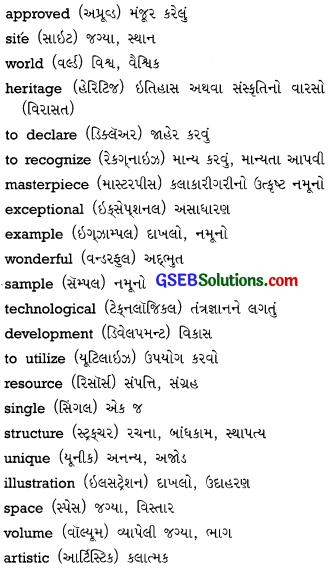
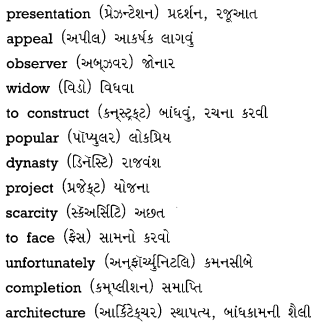
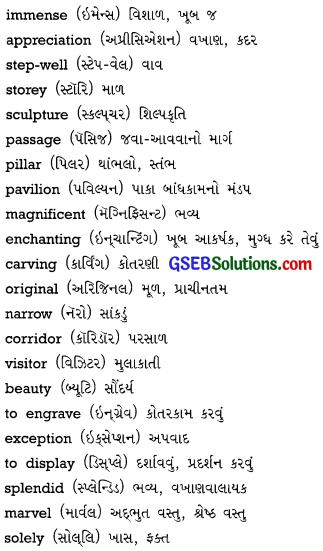
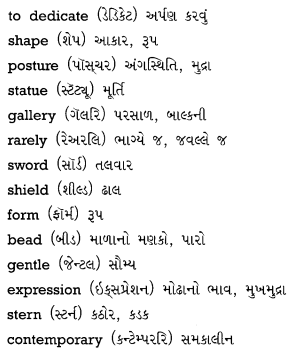
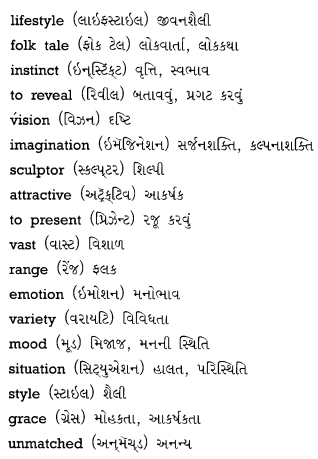
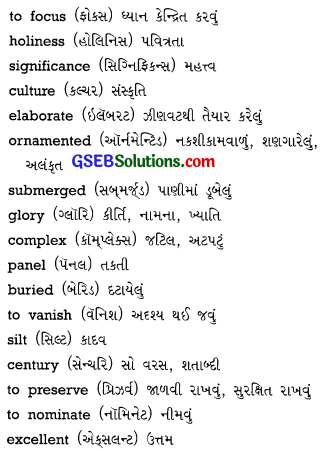
Idioms and Phrases
(1) to belong to
Vishwas belongs to the royal family of Junagadh.
![]()
(2) at present
How many women pilots are there at present?
(3) In fact
I am tired of work. In fact, I am thinking of taking a vacation.
(4) to add to
The sunset added to the beauty of nature in the hills.